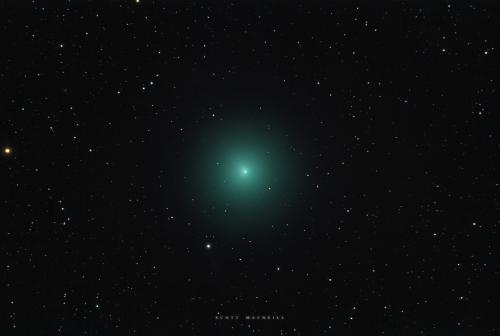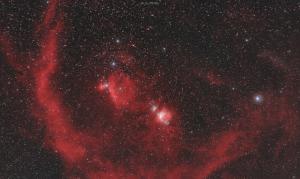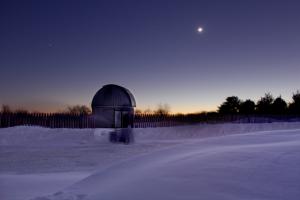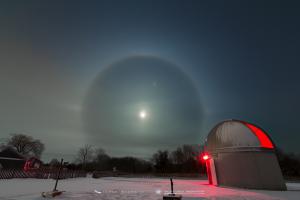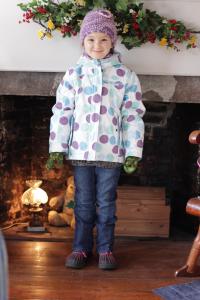Celebration of Space - January 24, 2020
Last Friday (January 17, 2020) we wrote a bit about Comet C/2017 T2 PANSTARRS (Comet T2), with the hopes of catching a first view of it at the observatory that night. Well, the skies were quite fabulous and we did catch a beautiful view of the comet in our telescope. One attribute we noticed quite quickly is how small the comet is in the view. Using the camera we were able to spot a small tail, which was not visible when observing visually. There have been rumors on the web that Comet T2 is a binocular visible target, though we did not come to that conclusion. The comet remains quite dim and was even difficult for visitors to identify in our primary 16” telescope without assistance. We do not expect a significant increase in brightness as this time, though the comet is a long period comet (comets with greater than 200 year orbital periods), which makes it quite unpredictable. The comet could experience an outburst which will dramatically increase its brightness as well as the size of its coma (thin atmosphere that forms around the comet’s nucleus). Though nothing is guaranteed. Comets are also notably difficult to predict in regards to outbursts and overall brightening. For those looking to catch a view (or photo) of Comet T2, the next few nights will be the best time to do so. This is because Comet T2 will be visibly passing within less than one degree of the spectacular Perseus Double Cluster, which are two open star clusters that reside very close to each other. If choosing to observe, the comet will appear as a diffuse region that will be situated within 20 arc minutes (0.33°) north of the Double Cluster. If you happen to catch a photo of Comet T2, post it to the Visitor Posts section of our Facebook page or tag us in your post, and we’ll share it to our timeline.
One of the best objects that we view at Frosty Drew Observatory during the winter months is the beautiful Orion Nebula, which is the closest site of massive star formation to the Solar System. The Orion Nebula is also one of two naked-eye-visible star forming nebulae in the northern hemisphere. Most of you have probably already seen it in the sky, but thought it was a star. The nebula, which has the designation Messier 42, is the middle star in the constellation Orion’s sword, which looks like three faint stars that sit below Orion’s belt in a perpendicular fashion. Though the Orion Nebula is indeed stunning, it is part of a much larger active region of space called the Orion Molecular Cloud Complex. This complex is comprised of numerous nebulae and star clusters including the Horsehead Nebula, the Flame Nebula, the Orion Nebula, NGC 1977 nebula, Barnard’s Loop – a supernova remnant, the Lambda Orionis Molecular Ring, and more. Some of these objects are easily visible to the naked eye, others only in binoculars or a telescope, with others only visible to CCD and CMOS. Regardless, this region is home to many very young stars, some with proto-planetary disks (infant planetary systems). Stop in at Frosty Drew Observatory during the winter months to catch a view of the many objects that are found in the Orion Molecular Cloud Complex. In the meantime, check out this fabulous image of Barnard’s Loop and much of the Complex, captured by local astrophotography rock star James Crouch, and see if you can spot the numerous celestial objects in the shot.
During the winter season in New England, it gets cold. I understand that this would appear to be an obvious observation, though it seems that many residents of the region forget this, or, at best, conveniently overlook it. We do not say that unkindly, it’s just what we have observed. Specifically on nights at the Frosty Drew Observatory where the temperatures drop below 20°F. On these nights we often implement a requirement for visitors to dress appropriately to enter the observatory building. Our reasons are not to make it difficult for visitors to observe, but actually the opposite.
On these cold nights, visitors who are dressed properly will have their view in the telescope ruined due to the presence of those who did not dress properly. This happens due to a few reasons. Firstly, the observatory building is not heated, and the inside of the building needs to be at the same temperature as the outside air. Otherwise convection will occur, with heat rising out of the open roof, passing the front of the telescope. The telescope will magnify these convective currents as well, which will cause significant blurring of the celestial object the telescope is focused on when observing through the telescope eyepiece. Secondly, you will radiate heat. In essence you are a 98.6° heater in the room. Depending on how you are dressed will directly relate to how much heat you radiate into the air. Any heat that you radiate will increase the temperature inside the dome and cause the problems listed in the first reason. Lastly, those who dress inappropriately will experience rapid onset of frostbite as well as hypothermia, which often induces panic. This panic causes the visitor to start moving around the room quite erratically, increasing the likelihood of a fall or causing another visitor to fall. It also makes the visitor quite agitated and, at times, prone to hostility.
There are numerous safety implications as well concerning inappropriately dressing for the winter elements. We will not touch base on most of them, though there is one that we see frequently and it troubles us. That is the presence of young children that are not dressed properly. As parents we should be taking the proper steps to prepare our children for a safe night out. Having your child show up without a hat, wearing Converse sneakers, with ankles exposed, no gloves, and a casual jacket is dangerous! Please do not bring your children to the observatory dressed inappropriately for the cold, especially when temps / wind chills are in the teens or lower. They will not have a good time.
What do we mean when we say “dressed inappropriately”? We are not talking about showing up with the wrong brand of clothing or jeans vs powder pants. We’re talking about visitors showing up wearing only a hoodie and sweatpants; or wearing wing-tips, slacks, and a peacoat with no scarf or hat; a jean jacket and sneakers, a varsity jacket. These are NOT adequate articles of clothing for sub 20° temps / wind chills. We wrote an extensive article on how to dress for all-night winter stargazing at Frosty Drew Observatory. The article can be read here. We also have a section on our Visiting the Observatory page about dressing for winter conditions.
Many visitors who arrive at the observatory with inappropriate winter attire are likely under the impression that the observatory building is heated. This mistake can be easily remedied by doing a little research before visiting. We have assembled an extensive spot of information about visiting the observatory, and we link to this page on all of our events, emails, and web pages. One of our goals at Frosty Drew is for all visitors to have a fabulous night out with our astronomers under the stars. Dressing properly will not only make the difference between that fabulous night out and a miserable night in the cold, it will also allow other visitors who did dress properly to experience the cosmos at their best, without being inhibited by your lost heat.
As a side note, for the select few that we have met that think they are too tough for winter attire. Let us gladly inform you that you’re not.
- Author:
- Scott MacNeill
- Entry Date:
- Jan 24, 2020
- Published Under:
- Scott MacNeill's Columns

